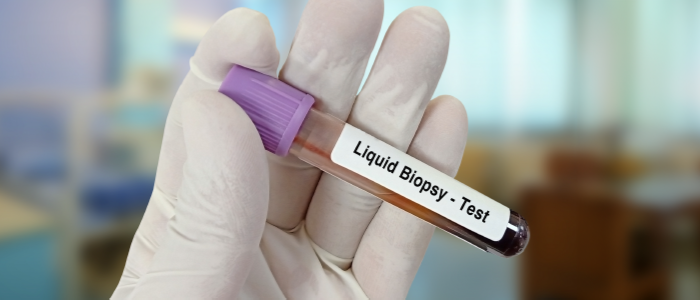
Cancer, with its intricate web of complexities, has long posed a formidable challenge to medical science. However, recent breakthroughs in diagnostic techniques have given birth to a powerful ally in the battle against this relentless foe – liquid biopsy. This innovative approach is proving to be a game-changer in the realm of lung cancer treatment, offering a range of benefits, novel treatments, and promising future possibilities.
Understanding Liquid Biopsy
Liquid biopsy, a non-invasive diagnostic method, holds the key to unlocking critical information hidden within the bloodstream. Unlike traditional tissue biopsies that require invasive procedures, liquid biopsy harnesses the potential of bodily fluids, such as blood or urine, to reveal vital insights into a patient's health. In the context of lung cancer, this approach involves the detection and analysis of circulating tumor cells (CTCs) and circulating tumor DNA (ctDNA) released by cancer cells into the bloodstream. The real magic lies in its ability to identify genetic mutations, alterations, and other biomarkers that provide a comprehensive portrait of the disease's progression.
Benefits of Liquid Biopsy in Lung Cancer Treatment
1. Early Detection and Diagnosis
The Achilles' heel of lung cancer has been its asymptomatic nature in its initial stages. Here, liquid biopsy emerges as a shining beacon, enabling oncologists to detect minute traces of ctDNA even before visible symptoms surface. This early detection opens the door to timely interventions, potentially curbing the disease's advancement and significantly improving treatment outcomes.
2. Precision Treatment Tailoring
The era of personalized medicine has dawned, and liquid biopsy is at its forefront. By unraveling the genetic makeup of a patient's tumor, this approach allows clinicians to pinpoint specific mutations and alterations that drive the cancer's growth. Armed with this knowledge, targeted therapies can be administered, honing in on the precise molecular culprits and minimizing collateral damage to healthy cells. In lung cancer cases, notorious mutations like EGFR mutations can be promptly identified, leading to more effective and tailored treatments.
3. Monitoring Treatment Efficacy
Cancer treatment is a dynamic process, and assessing its effectiveness is paramount. Traditional methods involved repeated tissue biopsies, but liquid biopsy offers a real-time alternative. By tracking changes in ctDNA levels and biomarkers, healthcare professionals can gauge the treatment's impact and make timely adjustments if needed. This not only enhances the patient's quality of life but also maximizes the therapeutic benefits.
4. Detection of Treatment Resistance
The resilient nature of cancer cells often leads to the development of treatment resistance. Liquid biopsy emerges as a powerful tool in identifying these shifts early on, providing crucial insights into the evolution of the disease. Armed with this knowledge, oncologists can alter treatment strategies promptly, aiming to outmaneuver cancer's adaptive tactics.
Current Treatments Enhanced by Liquid Biopsy
1. Targeted Therapies
Lung cancer, notorious for its diversity, demands a nuanced approach. Liquid biopsy's ability to unravel a tumor's genetic profile paves the way for targeted therapies. Medications designed to interact with specific mutations or biomarkers can be administered, honing in on the cancer's vulnerabilities with precision.
2. Monitoring Disease Progression
In cases where traditional tissue biopsies are challenging, such as inoperable tumors or when a patient's health is compromised, liquid biopsy stands as a reliable alternative. Regular monitoring of ctDNA levels and biomarkers paints a comprehensive picture of disease progression, enabling oncologists to make informed decisions without subjecting the patient to invasive procedures.
Future Possibilities
As we stand at the crossroads of medical innovation, the future possibilities of liquid biopsy in lung cancer treatment are nothing short of breathtaking.
1. Improved Screening and Early Intervention
The integration of liquid biopsy into routine screenings could potentially transform lung cancer care. With its ability to detect ctDNA at incredibly early stages, this approach could become a powerful tool for population-wide screenings, resulting in timely interventions that save lives.
2. Tailored Immunotherapies
Immunotherapy, a rising star in cancer treatment, could be further elevated by liquid biopsy. By assessing the tumor's molecular profile, a liquid biopsy may aid in identifying patients who are most likely to respond positively to immunotherapies, ensuring that resources are channeled where they can make the most impact.
3. Disease Monitoring Beyond Treatment
The story doesn't end with treatment completion. Liquid biopsy's non-invasive nature makes it an ideal tool for long-term monitoring after treatment, detecting potential relapses or lingering traces of cancer. This capability offers reassurance to patients and ensures that any resurgence is promptly addressed.
Conclusion
The realm of lung cancer treatment is undergoing a profound transformation, courtesy of the liquid biopsy. With its early detection capabilities, precision treatment tailoring, and real-time monitoring prowess, this non-invasive approach is revolutionizing the way we battle cancer.
As research advances and technology refines, liquid biopsy tests in Bangalore are poised to become an indispensable tool in the oncologist's arsenal at Cancer Therapy India, leading to improved patient outcomes, enhanced quality of life, and a brighter horizon in the fight against lung cancer.